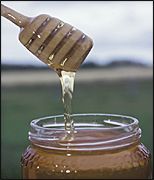Whether you accept it, avoid it or live somewhere in between, insurance coverage has become a defining issue for our profession. Patients increasingly expect to use their benefits, practitioners want to be compensated fairly for their time and expertise, and the system itself remains – at best – fragmented. The encouraging news is that coverage has expanded in meaningful ways. The challenging news is that reimbursement, across the board, remains inadequate.
Herbs & Botanicals
Honey (feng mi)
What is honey? What is it used for?
Honey is a sweet, natural fluid produced by bees and derived from the nectar of flowers. Natural, raw honey is actually sweeter than table sugar, and has a distinctive flavor that some people prefer to sugar and other sweeteners. Because of its extremely high sugar content and its low moisture content, liquid honey does not spoil; it can actually kill bacteria and airborne yeasts that it comes in contact with.
The flavor and color of honey is determined largely by the types of flowers from which nectar is gathered. Several types of honey exist, some with very strong (or mild flavors) and light (or dark) colors. Most commercially available honey consists of a variety of other blends. In addition to its uses in cooking, baking and as a general food, honey has a variety of medicinal uses.
 Based on the principles of traditional Chinese medicine, honey has sweet and neutral properties, and is associated with the Lung, Large Intestine, Spleen and Stomach meridians. Its main functions are to tonify the spleen and stomach, to restore qi, and to prevent dryness. It is also one of the most common ingredients of herbal pills, capsules and formulas, and is often added to herbal preparations to make them taste better and be easier to consume.
Based on the principles of traditional Chinese medicine, honey has sweet and neutral properties, and is associated with the Lung, Large Intestine, Spleen and Stomach meridians. Its main functions are to tonify the spleen and stomach, to restore qi, and to prevent dryness. It is also one of the most common ingredients of herbal pills, capsules and formulas, and is often added to herbal preparations to make them taste better and be easier to consume.
The known medicinal uses of honey are too numerous to mention in one article, but it has been used over time as a laxative, a demulcent (to soothe and soften inflamed membranes), an emollient (in the treatment of chronic bronchitis), and as a remedy for dry throat and dry mouth. It has been used to treat coughs, stomach pain, burns, dry skin, and constipation, and to enhance the functioning of the immune system in the elderly population. Honey has also been used as a sort of antidote to help fight the toxic properties associated with aconite root and prepared aconite.
How much honey should I take?
The amount of honey to be taken depends on the condition being treated. There are not set therapeutic doses for honey, but some practitioners recommend that people consume between 10 and 75 grams of honey per day for general health and wellness and to promote the function of the immune system.
What forms of honey are available?
Honey is widely available at supermarkets, organic health food stores, Asian markets, herbal shops, and various other locations. It can be taken raw or as an infusion, pill, powder or extract, either alone or with other items.
What can happen if I take too much honey? Are there any interactions I should be aware of? What precautions should I take?
Honey is considered extremely safe. Because of its laxative properties, however, honey should not be consumed by patients with loose stools or diarrhea. Honey may also be potentially dangerous for infants due to the possibility of botulinum spores, which can survive in honey and may affect an infant's digestive system. Incidences of infant botulism are extremely rare, however, especially when commercially produced honey is used. As always, make sure to consult with a licensed health care provider when using honey as a dietary supplement.
References
- Biswal BM, Zakaria A, Ahmad NM. Topical application of honey in the management of radiation mucositis. A preliminary study. Support Care Cancer 2003;11:242-248.
- Cooper RA, Molan PC, Harding KG. The sensitivity to honey of gram-positive cocci of clinical significance isolated from wounds. Journal of Applied Microbiology 2002;93:857-863.
- Molan PC. The potential of honey to promote oral wellness. General Dentistry 2001;49 (6):584-9.
- Postmes T, van den Bogaard AE, Hazen M. Honey for wounds, ulcers and skin graft preservation. Lancet 1993:341(8847):756-57.
- Wahdan HAL. Causes of the antimicrobial activity of honey. Infection 1998;26:30-35.


